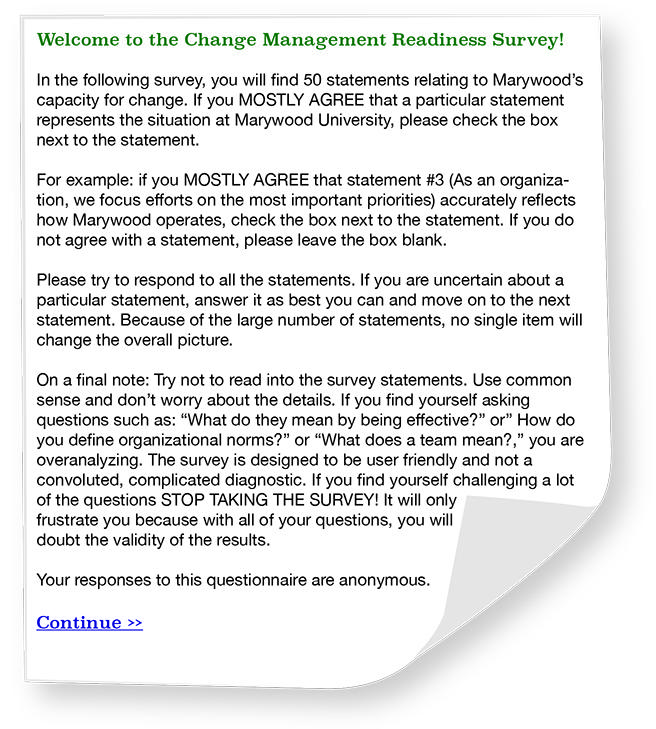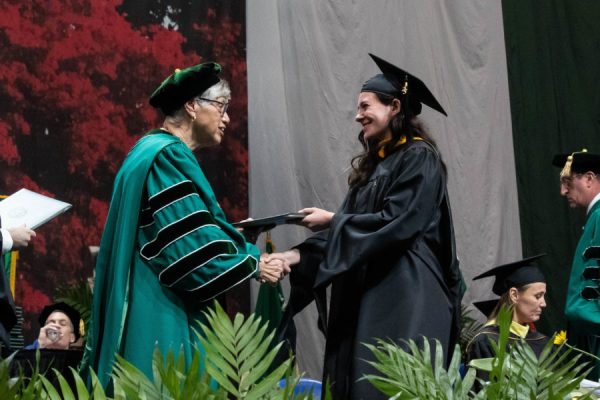Admins say readiness survey showed campus is “moderately prepared” for SRA process
Photo credit/ Kelsey Van Horn
December 2, 2015
Dr. Alan Levine, vice president for academic affairs, and Joseph X. Garvey, vice president for business affairs and treasurer, announced in a joint message to Marywood employees the results of the readiness survey, taken earlier in the month.
According to the email, the campus is only “moderately prepared” for the upcoming changes, due to a low means to a few key areas of response.
The responses to the questions about the respondents’ “personal commitment to this change effort,” had a mean of 7.22 out of 10.
“My confidence level regarding the adequacy of resources for this change effort,” had a mean of 4.86.
“I believe our organization’s overall readiness for this change effort” was a mean of 4.85.
All results were given in terms of means, as opposed to other methods, such as percentages. Two hundred sixty-three full-time Marywood employees completed the survey. According to Garvey, Marywood currently has between 515 and 520 full time employees.
Levine and Garvey, who are co-chairs of the Coordinating Committee that is part of the Strategic Resource Allocation process, preempted the results by explaining the process of how they were gathered.
“The purpose of the survey was to gain a general understanding of the campus capacity and readiness for change,” the email stated. “The survey was not intended to be a scholarly endeavor, but rather a broad gauge of our faculty and employee temperament during these challenging times.”
Other aspects of the survey reflect an overall dissatisfaction with the culture of campus.
Garvey and Levine specifically cite the question about “Culture, representing responses for items related to trust, openness, adaptability, flexibility and ability to deal with conflict within our organization” which had the lowest mean of 1.79.
Other means below the score of three are as follows.
“Collaboration,” representing responses for our ability to collaborate and establish a positive working relationship, had a mean of 2.87.
“Leadership,” representing the ability and attributes of our leadership—both mid-level and senior—to lead the change efforts, had a mean of 2.76.
The co-chairs said in the email that the survey reveals the importance of the SRA process.
“In any case, it is clear to all that our University must address our financial challenges–sooner rather than later,” the co-chairs said in their email. “We are nine weeks into our SRA process and, while no process is perfect, the process we’re using, particularly through the website and the task forces, has been recognized on campus as transparent and fair.”
The co-chairs also address criticisms that have arisen in regards to the survey, attempting to dispel them.
“The readiness survey provides a very general pulse-taking of employees of this University” they stated. “And, while scholars can dispute the survey method, the results are real.”
“I’m confident it represents the real response,” said Garvey, a co-chair of the coordinating committee.
Dr. Ed O’Brien, professor of psychology and counseling, who levied the most vocal criticism against the survey, stated that there are still significant issues to be addressed in the survey’s results.
O’Brien said that a survey such as this one built for one of his classes would be met with a failing grade.
“This would be an ‘F’ grade in my class if it was a sophomore research paper,” O’Brien said.
Some of O’Brien’s criticisms of the survey results include the lack of any sort of unit of measurement. The means for only three questions are defined as being on a one to 10 scale, with the rest being undefined. He also cited a lack of standard deviations, and a failure to state how many people the survey was sent to.
“You have no way to know if [the scores] are high numbers or if they’re low numbers,” O’Brien said. “There are no norms, and you don’t even know what items were added together. It’s essentially uninterpretable.”
In response to these criticisms, Garvey said he maintains that the Goldstein Model is being followed correctly.
“[The results were] presented in the form it was because that is how the Goldstein Model presents it,” said Garvey.
Due to the alleged uninterpretable nature of the results, O’Brien said he is uneasy about the use of the survey in the decision-making process.
“If you’re using a poor instrument, you’re going to make poor decisions,” O’Brien said.
Despite this, Garvey says the administration’s position is steadfast.
“I know that people, many individuals feel that the readiness survey should dictate whether the strategic asset resource allocation should move forward, but regardless of perhaps individuals’ dissatisfaction with it or indicators that the school may not be ready for it, the SRA project is moving forward,” said Garvey. “That’s the administration’s position.”
Contact the writers: [email protected]
@PKernanTWW















